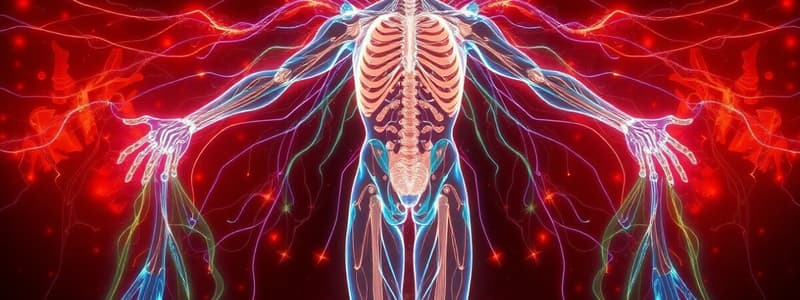Podcast
Questions and Answers
Which of the following is NOT a consequence of oxidative stress on the skin?
Which of the following is NOT a consequence of oxidative stress on the skin?
- Loss of skin elasticity
- Fine wrinkles
- Dark spots
- Increased collagen and elastin production (correct)
Excessive exposure to UV radiation can contribute to hyperpigmentation.
Excessive exposure to UV radiation can contribute to hyperpigmentation.
True (A)
What are the three essential components that cells need to thrive and function properly?
What are the three essential components that cells need to thrive and function properly?
Food (nutrition), oxygen, and water
The organelle responsible for protein synthesis within a cell is called a ______.
The organelle responsible for protein synthesis within a cell is called a ______.
Match the following skin concerns with their primary cause:
Match the following skin concerns with their primary cause:
Which of the following is an intrinsic factor that can cause hyperpigmentation?
Which of the following is an intrinsic factor that can cause hyperpigmentation?
Consuming excessive amounts of sugar and dairy products can lead to proper cellular function.
Consuming excessive amounts of sugar and dairy products can lead to proper cellular function.
Explain how oxidative stress affects the skin's barrier function.
Explain how oxidative stress affects the skin's barrier function.
Which body system is primarily responsible for movement?
Which body system is primarily responsible for movement?
The integumentary system is primarily made up of bones and joints.
The integumentary system is primarily made up of bones and joints.
What is the function of the digestive system?
What is the function of the digestive system?
The _____ system eliminates wastes from the body.
The _____ system eliminates wastes from the body.
Match the following body systems with their primary functions:
Match the following body systems with their primary functions:
What is one function of the skeletal system?
What is one function of the skeletal system?
The muscular system does not assist with body temperature regulation.
The muscular system does not assist with body temperature regulation.
What is the largest organ of the body?
What is the largest organ of the body?
Which system is responsible for processing food and removing waste from the body?
Which system is responsible for processing food and removing waste from the body?
The sympathetic nervous system relaxes the body's systems.
The sympathetic nervous system relaxes the body's systems.
What are the primary organs involved in the respiratory system?
What are the primary organs involved in the respiratory system?
The __________ system secretes hormones and regulates bodily processes.
The __________ system secretes hormones and regulates bodily processes.
Which glands are part of the endocrine system?
Which glands are part of the endocrine system?
The excretory system is involved in nutrient absorption.
The excretory system is involved in nutrient absorption.
What role does the parasympathetic nervous system play in the body?
What role does the parasympathetic nervous system play in the body?
Flashcards
Integumentary system
Integumentary system
The skin and its accessories like hair, nails, and glands.
Skeletal system
Skeletal system
Provides support, structure, and enables movement.
What is the function of the skeletal system?
What is the function of the skeletal system?
Provides a framework for the body and allows movement with the muscular system.
Circulatory system
Circulatory system
Signup and view all the flashcards
What is the function of the muscular system?
What is the function of the muscular system?
Signup and view all the flashcards
Digestion
Digestion
Signup and view all the flashcards
Excretion
Excretion
Signup and view all the flashcards
Respiration
Respiration
Signup and view all the flashcards
Skeletal Muscles
Skeletal Muscles
Signup and view all the flashcards
Tendons
Tendons
Signup and view all the flashcards
Nervous System
Nervous System
Signup and view all the flashcards
Autonomic Nervous System
Autonomic Nervous System
Signup and view all the flashcards
Digestive System
Digestive System
Signup and view all the flashcards
Excretory System
Excretory System
Signup and view all the flashcards
Respiratory System
Respiratory System
Signup and view all the flashcards
Endocrine System
Endocrine System
Signup and view all the flashcards
Oxidative Stress
Oxidative Stress
Signup and view all the flashcards
Collagen and Elastin
Collagen and Elastin
Signup and view all the flashcards
Hyperpigmentation
Hyperpigmentation
Signup and view all the flashcards
Skin Barrier Function
Skin Barrier Function
Signup and view all the flashcards
Ultraviolet (UV) Radiation
Ultraviolet (UV) Radiation
Signup and view all the flashcards
Extrinsic Factors of Aging
Extrinsic Factors of Aging
Signup and view all the flashcards
Intrinsic Factors of Aging
Intrinsic Factors of Aging
Signup and view all the flashcards
Ribosomes
Ribosomes
Signup and view all the flashcards
Study Notes
Human Body Systems
- The Smallest Cell to a Complete Body System Functions Together:
- Human life processes
- Organization
- Metabolism
- Responsiveness
- Movement
- Reproduction
- Growth
- Respiration
- Digestion
- Excretion
The 10 Body Systems
- Skeletal: Provides a framework for the body.
- Muscular: Allows body movement.
- Circulatory: Moves blood through the body.
- Nervous: Sends and receives messages.
- Digestive: Supplies nutrients to the body.
- Excretory: Eliminates wastes from the body.
- Respiratory: Provides oxygen and eliminates CO2.
- Endocrine: Controls growth, reproduction, health.
- Reproductive: Generation of new life.
Integumentary System
- Covers and protects the entire body.
- Made up of skin and its accessory organs (sensory receptors, hair, nails, oil and sweat glands).
- Largest organ of the body.
- First-line defense against infection and water loss.
- Regulates temperature.
- Perceives sensation and produces vitamin D.
- Has absorption capabilities.
- Skin and its accessory organs (oil and sweat glands, sensory receptors, hair, and nails) are crucial components in a skin care therapist's success.
Skeletal System
- Supports the body and enables movement with muscles.
- Contains cartilage, bone, and joints.
- Important in protecting body mechanics and landmarks.
- Provides shape and structure.
- Protects internal organs.
- Provides muscle attachment sites.
- Produces blood cells.
- Stores calcium.
Circulatory System
- Delivers oxygen and nutrients; equalizes body temperature.
- Works with lymphatic channels.
- Health of this system affects skin tissue.
- Contains the heart, blood vessels and blood.
Muscular System
- Works with the skeletal system for body temperature regulation.
- Covers, shapes and supports skeletal tissue.
- Contracts and moves parts of the body (muscles).
- Important for massage and electrical treatments.
- Prevents motion fatigue.
Nervous System
- Activates body responses and processes sensory information.
- Contains brain, spinal cord, and peripheral nerves.
- Important to know location of facial nerves for treatments.
- Contains sympathetic and parasympathetic nervous systems.
Digestive System
- Processes food, absorbs nutrients, and removes wastes.
- Contains organs like stomach, liver, gall bladder, large intestine, and small intestine.
- Good nutrition supports all body systems.
Excretory System
- Controls water balance.
- Removes waste from blood.
- Excretory organs are kidneys and urinary bladder.
Respiratory System
- Enables breathing.
- Supplies the body with oxygen & removes carbon dioxide.
- Includes nasal passages, trachea, and lungs.
- Adequate oxygenation supports cell function.
Endocrine System
- Secretes hormones and regulates bodily processes.
- Affects growth, development, and sexual activities.
- Consists of specialized glands (pituitary, thyroid, pancreas, adrenal, testes, and ovaries).
- Hormones affect skin health (acne breakouts, hair growth, and skin oiliness or dryness).
Immune / Lymphatic System
- Returns fluid to blood.
- Defends against pathogens.
- Develops resistance to disease.
- Includes thymus, lymph nodes, spleen, and lymphatic vessels.
- Important role in many treatments.
Reproductive System
- Produces children and transmits genetics.
- Involves combining tissues to function as organs.
- Cells working together form tissues, grouping of tissues form organs.
Skin Foundations - Oxidative Stress
- Skin care is about internal and external health.
- Chronic oxidative stress accelerates skin aging (loss of collagen/elastin, wrinkles, sagging, dark spots).
- Oxidative stress impacts skin barrier function, sensitivity, and moisture.
- Nutrition influences cellular beauty. Cells need proper nutrition, oxygen and water.
Hyperpigmentation
- Excessive UV radiation is a common cause.
- UV radiation increases melanin production, darkening the skin.
- Intrinsic factors (hormonal imbalances) can also contribute to hyperpigmentation.
- Proper nutrition (from fruits, vegetables, oxygen, and water) can support healthy cell function. Excessive sugar, dairy and other inappropriate foods can contribute to oxidative stress.
Studying That Suits You
Use AI to generate personalized quizzes and flashcards to suit your learning preferences.





